User guide
Everything you need to know about MyCrossword's key features and tools designed to help you create, review, and publish cryptic crosswords. Whether you're setting your first puzzle or honing your skills, you'll find everything you need to manage grids, clues, and settings with ease.
Filling your gridThe first step in creating a crossword is to fill your grid with solutions. A good approach is to start by placing a few key words you already have in mind, then focus on the longer entries before filling in the shorter ones. This may seem challenging at first, but with practice, you'll find it becomes more intuitive.
The easiest way to fill a grid is by clicking the Edit grid button to open the grid fill assist tool.
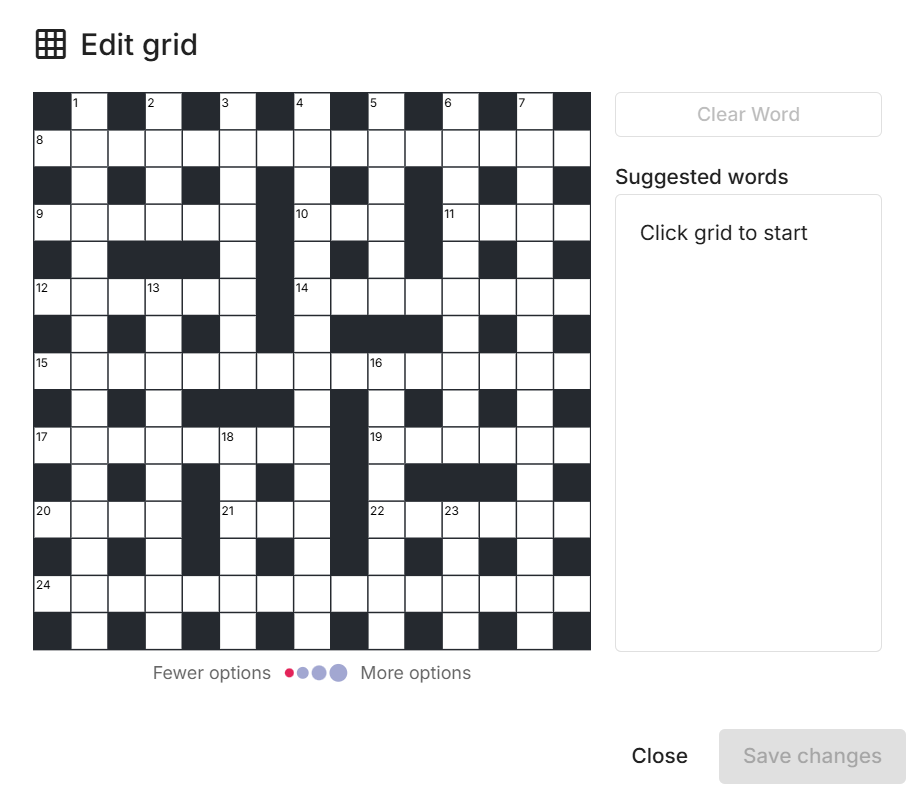
Clicking on a square will display a list of suggested words that fit in that slot. As you type letters into the grid, the list will automatically update, narrowing down the possibilities. Click on a suggestion to insert the entire word.
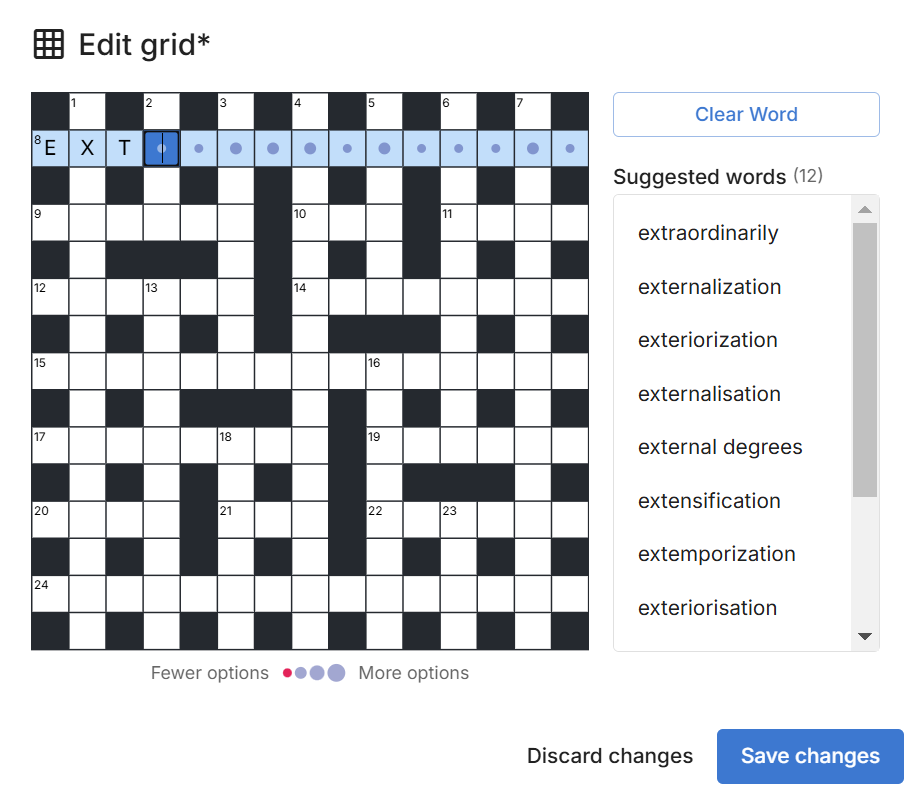
The circles in the grid indicate how many letters can fit into each square. Large circles allow multiple letters, small circles accommodate fewer letters, and red circles indicate that no letters can be entered.
When you insert a suggested word, crossing words will be automatically checked for available options. This helps you spot potential dead ends early in the process. Once you're satisfied with your grid, click the Save changes button. You don't need to complete the entire grid in one go, you can always return to it later.
Editing your cluesClues are displayed beneath the grid. To edit a clue, click on it to expand the editable fields. Each clue consists of the following parts:
Devices
A list of clue types used in the puzzle. More details can be found below.
Solution
The text displayed in the grid. You can add spaces or hyphens to adjust the enumeration.
Clue
The text displayed in the clue list.
Explanation
The text shown in the annotated solutions dialog, explaining how the clue works.
Notes
Private notes that won't be visible to solvers, allowing you to jot down ideas or reminders for the clue.
Mark as complete
A checkbox to indicate that the clue is finished and ready for publication, helping you track your progress.
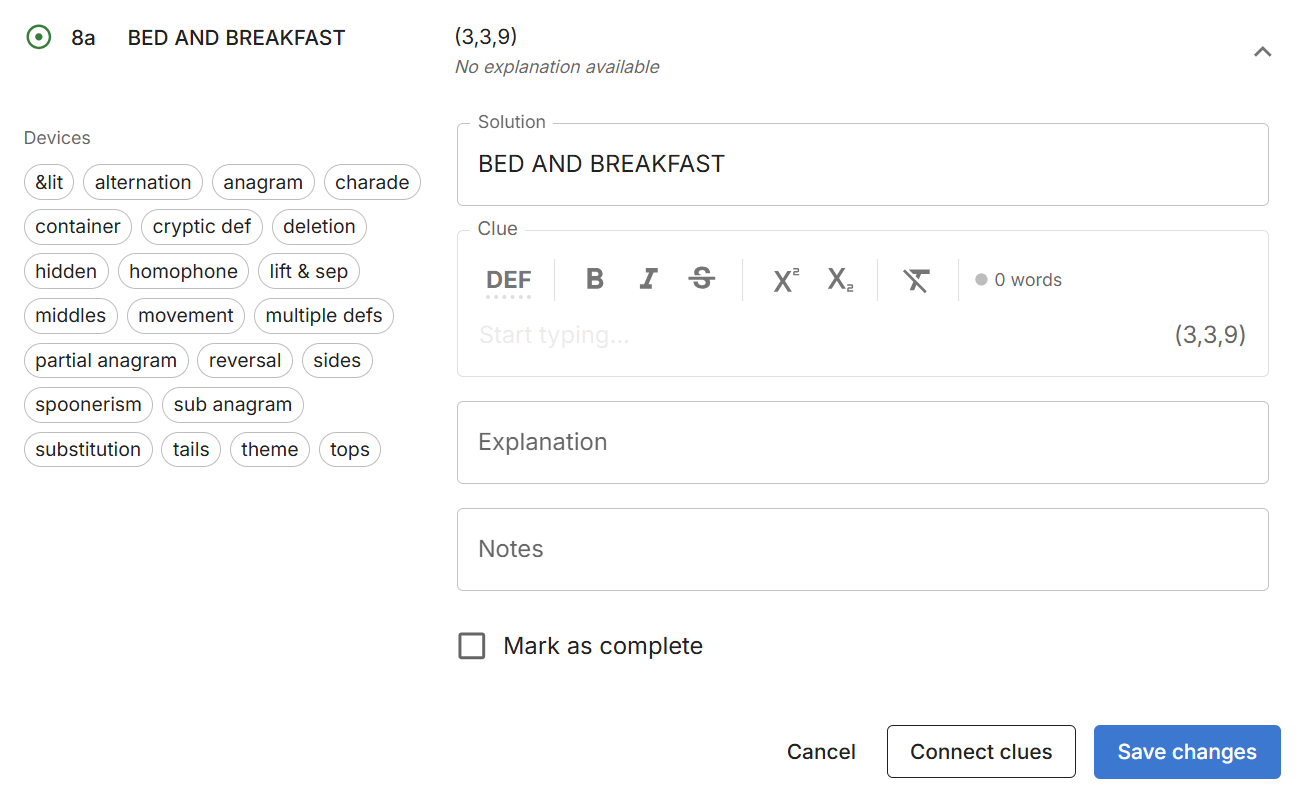
The clue editor includes various controls for formatting and annotations. The DEF button allows you to underline the clue's definition, which won't appear in the clue text but will be shown in the annotated solutions. You can also apply bold, italic, strikethrough, superscript, and subscript formatting. Additionally, there's a word counter to help you track each clue's length.

After making changes to a clue, click the Save changes button to apply them. If you want to discard any unsaved edits, click Cancel instead.
Managing devicesCryptic clues take many forms, from anagrams and homophones to hidden words and more. Keeping track of the devices you've used helps ensure variety and keeps your puzzle engaging.
To tag a clue with its devices, expand the clue and select the relevant options by clicking on them.
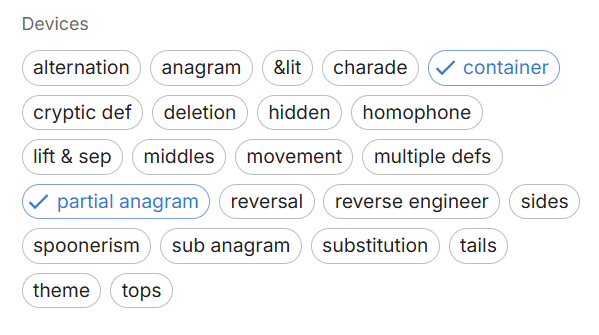
&lit
Whole clue is both definition and wordplay.
e.g. "Part of alphabet, Athenian?" -> "BETA"
Alternation
Selects alternate letters.
e.g. "Oddly specific" -> "S E I I"
Anagram
Rearranges letters.
e.g. "Listen" -> "Silent"
Charade
Combines smaller parts.
e.g. "Cat" + "Walk" -> "Catwalk"
Container
One word placed inside another.
e.g. "All About Eve" -> "A-LEVEL"
Cryptic definition
Misleading but accurate definition.
e.g. "Die of cold" -> "ICE CUBE"
Deletion
Removes letters.
e.g. "Man losing head" -> "(M)ALE"
Hidden
Solution is hidden within text.
e.g. "Composition from Bliss on a tape" -> "SONATA"
Homophone
Sounds like another word.
e.g. "Eight" sounds like "Ate"
Lift & separate
Splits a word into separate parts.
e.g. "Westbury needs a space" -> "West bury" -> "W+INTER"
Middles
Uses middle letters.
e.g. "Middle of fairway" -> "R"
Movement
Move letters to new position.
e.g. "Dave's cycling" -> "AVED"
Multiple definitions
Clue has two or more separate definitions.
e.g. "Blue feathers" -> "DOWN"
Partial anagram
Rearranges part of the solution, but not all.
e.g. "America got confused about relish" -> "US with GOT* about" -> "GUSTO"
Reversal
Letters are reversed.
e.g. "Stop going backwards" -> "POTS"
Reverse engineer
Solution is a clue for the clue.
e.g. "Tea?" -> "EAT OUT"
Sides
Uses first and last letters.
e.g. "Country's borders" -> "C+Y"
Spoonerism
Swap initial sounds of words.
e.g. "Cat flap" -> "Flat cap"
Sub anagram
Rearrange letters after subtracting others.
e.g. "Greatness is an unmitigated disaster without it" ->"UNM(IT)IGATED*" -> "MAGNITUDE"
Substitution
Replace a letter/segment with another.
e.g. "Close to dinner becoming cold" -> "change R to C"
Tails
Uses last letters.
e.g. "End of season" -> "N"
Theme
Clue or solution shares a common topic.
e.g. All solutions are rivers
Tops
Uses first letters.
e.g. "Start of event" -> "E"
You can view a breakdown of all devices used in the grid and their frequency. To see where a specific device appears, hover over its name in the list - corresponding entries will be highlighted in the grid.
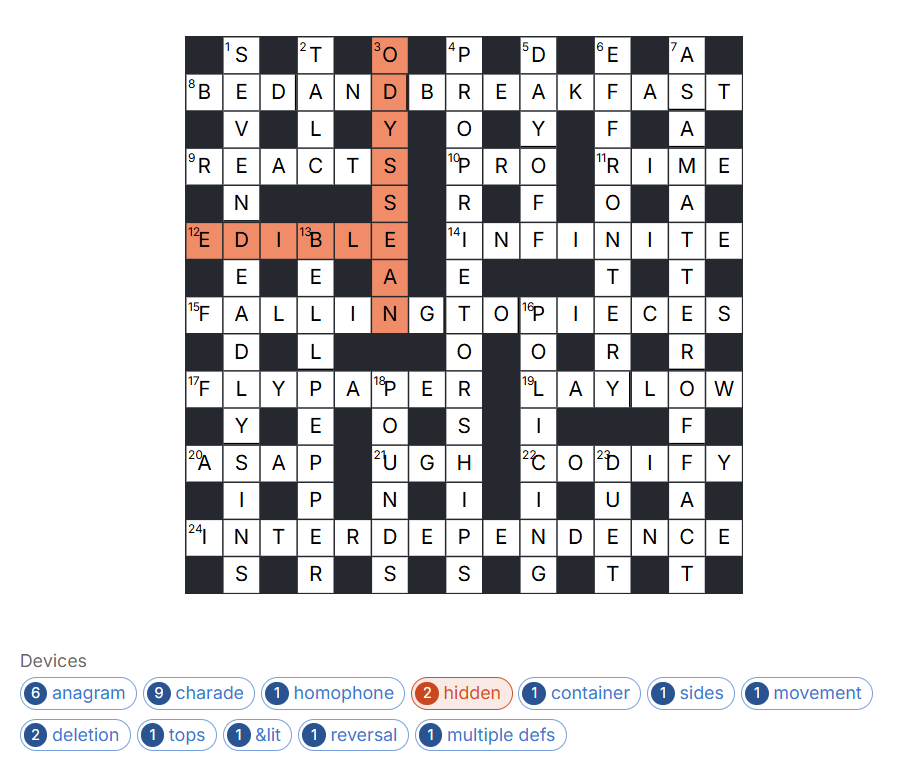
Device annotations are private notes for your own reference and aren't shown to solvers, with the exception of clues tagged with "theme", which will be highlighted in annotated solutions.
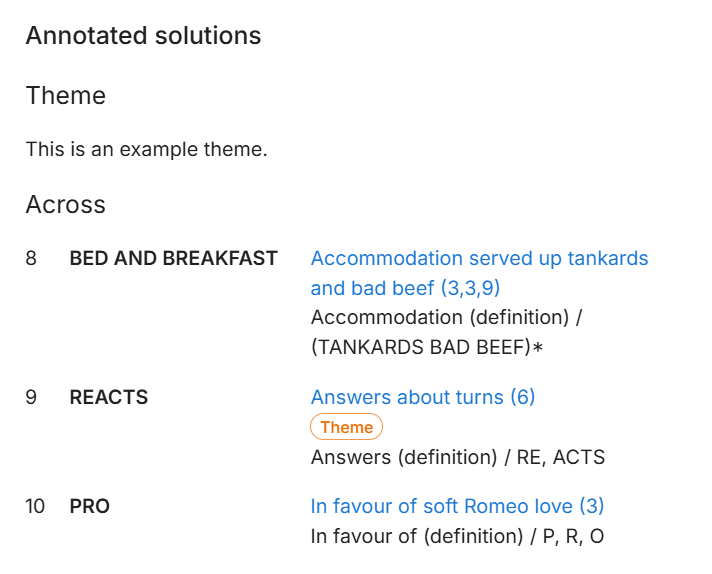
You may want to link multiple solutions in the grid to create a combined clue. To do this, open the clue you want to link and click the Connect clues button.
Select the clues you wish to link by clicking the plus icon. Once selected, you can drag and drop them to reorder as needed. When you're happy with the arrangement, click Update connections to apply the changes across all linked clues.
To disconnect clues, click the trash icon next to the solutions you want to remove, then click Update connections.
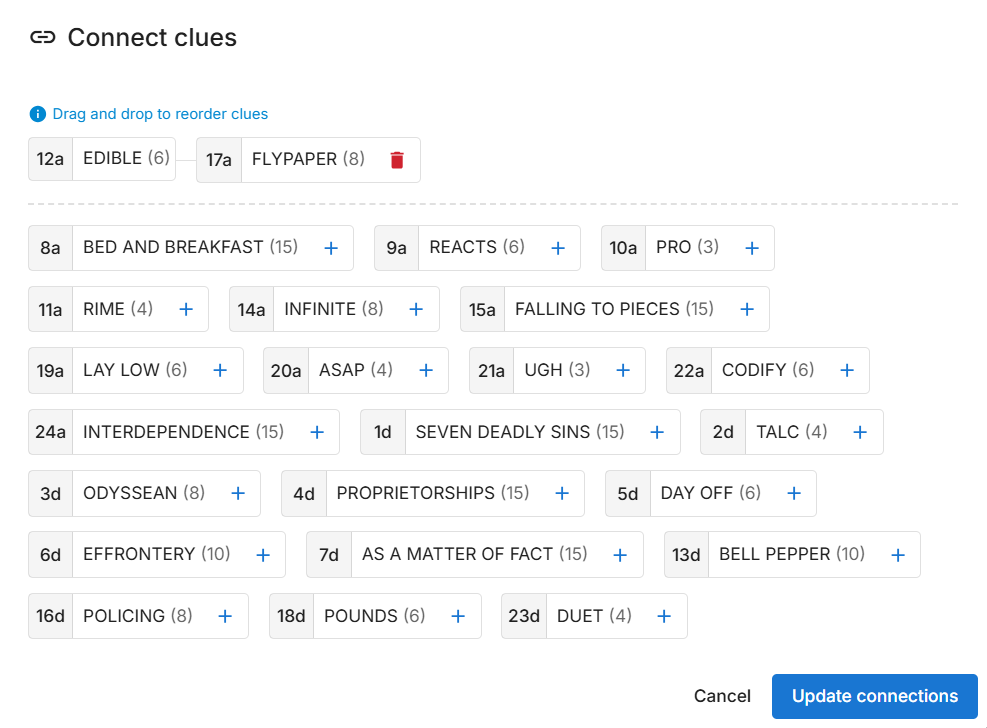
The collapsible, resizable sidebar provides various tools to assist in crossword creation. Click an icon to expand the relevant section.

Dictionary
Enter a word to view its definition and a list of synonyms.
Related words
Enter a word to explore related words, including synonyms, antonyms, homophones, context words, adjectives, and nouns. You can also filter results by part of speech.
Pattern matcher
Search for words matching a specific pattern. Use * as a wildcard for any sequence of letters and ? to represent a single letter.
Anagram builder
Enter a set of letters to generate words or phrases using those letters. The tool finds all possible anagrams, including single words and multi-word phrases, ignoring spaces in the input.
Abbreviations
Find common abbreviations for a given letter. You can filter results to show only those listed in Chambers Dictionary, the primary reference for cryptic crosswords in the UK.
Indicators
Browse a list of common indicators used in cryptic clues.
To view statistics about your crossword, click View stats in the Actions menu. This will display key information about the grid and clues.
The Average length shows the average number of words per clue. Aim to keep clues concise while ensuring a smooth surface reading.
The Anagram score represents the total number of anagrams, with full anagrams worth 1 point and partial anagrams worth 0.5. These scores are based on the clue's devices. Ideally, aim for an anagram score of 25% or below e.g., 7 points for a 28-clue puzzle.

You might also want to create a pangram - a grid that includes every letter of the alphabet. To check this, view the letter distribution of the grid.
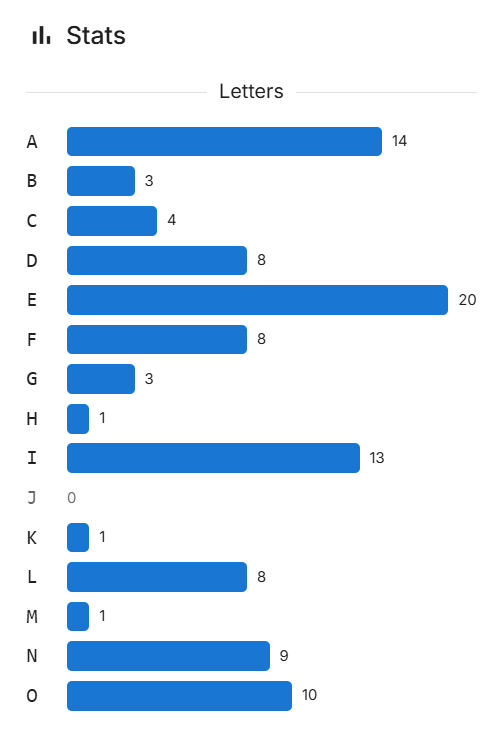
To provide clue explanations for solvers, click Solution & annotations in the Actions menu. Tick Show solutions and Show explanations, then click Update settings. This will display the text from the explanation field on the published puzzle.
To hide solutions from solvers, untick Show solutions and click Update settings. This prevents solutions from being checked or revealed in the published puzzle. However, this is not recommended unless you are running a competition.

Every published crossword requires a cover image. To add one, click Edit cover image in the Actions menu, enter a search term, and choose a suitable image. You can change the cover image after publication, but uploading your own image is not supported.
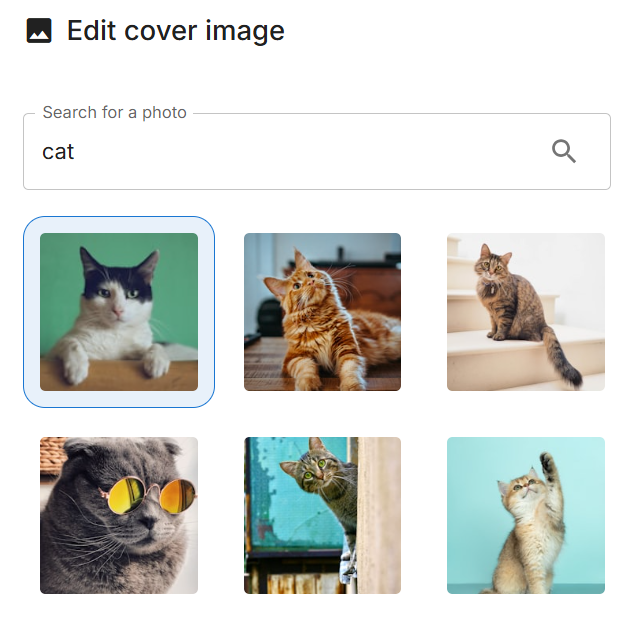
To preview your crossword before publication or share a review link with a fellow setter, click Preview crossword in the Actions menu. This will generate a preview link, which you can share by copying the URL from your browser's address bar.

Once you're satisfied with your crossword, click Publish crossword in the Actions menu. If there are any issues with your crossword, you will be prompted to resolve them before publication. Confirm that your clues have been checked, then click Publish crossword to share your puzzle with others on the site. A number will be automatically assigned, e.g., "Cryptic crossword No 42".
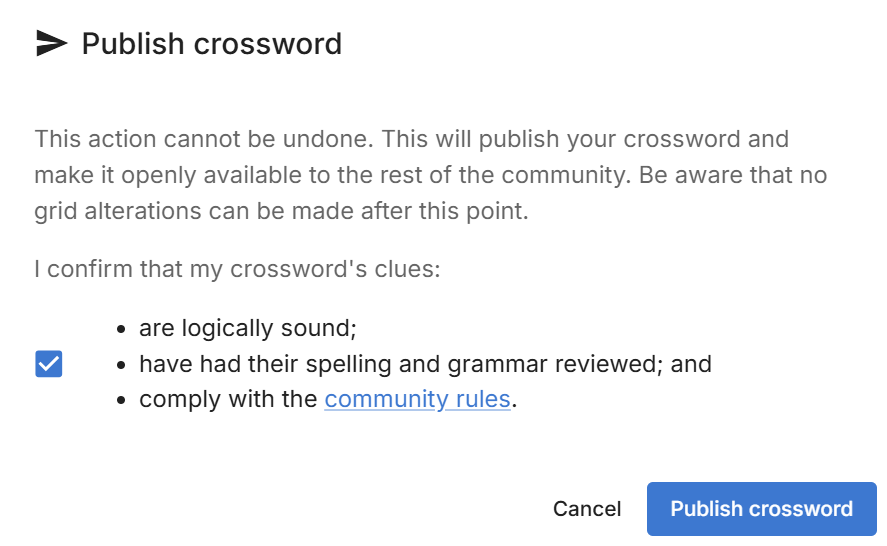
After publication, the crossword's grid cannot be changed. You can still edit clue text, and each amendment will be recorded in a publicly visible change log.
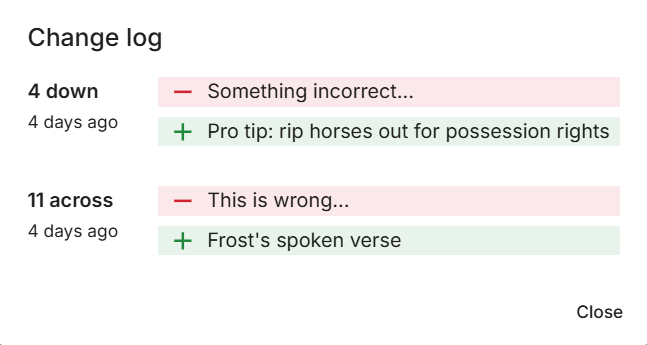
How do I change an enumeration?
A solution's enumeration (the number in brackets) is applied automatically. To include spaces or hyphens in the enumeration, open the clue and update the text in the Solution field. For example, changing "MOBILEPHONE" to "MOBILE PHONE" will adjust (11) to (6,5). If you need to update the enumeration with a set of connected clues, you can add spaces or hyphens to the start or end of the relevant solutions.
Can I edit the grid's light and dark squares?
No, the grid's layout is fixed and cannot be changed. There are plans to add this feature in the future.
How do I add special instructions?
Click Edit details in the Actions menu and enter some text in the Special instructions field. This will be displayed above the crossword when published.